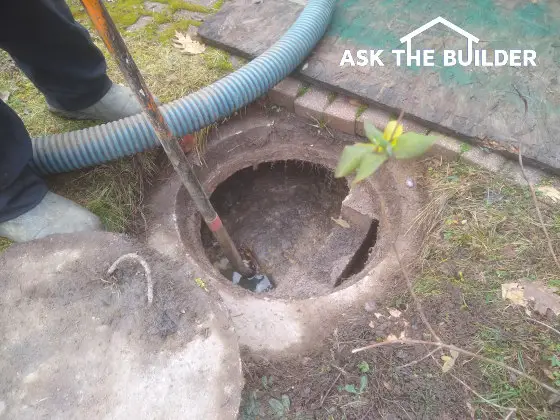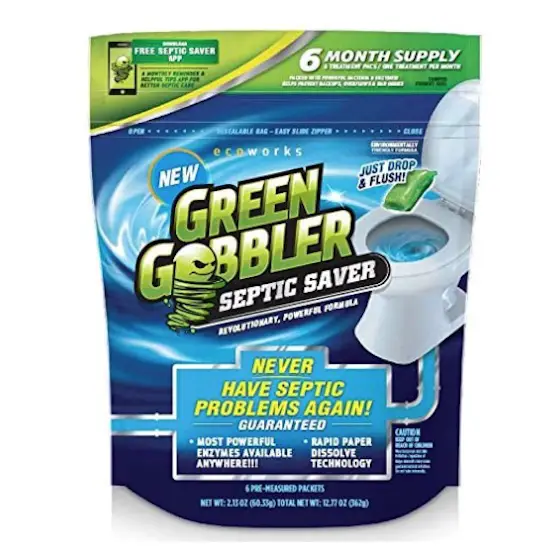House Drain Lines and Septic Tanks

Septic Tank Pumping | This is a septic tank about to be pumped. It’s a best practice to do this every two or three years. Septic tank cleaning should be done just as you clean your house. Copyright 2021 Tim Carter
Septic Tank Pumping - It's Really Important to Protect the Leach Field
QUESTION: Howdy, Tim. I discovered on your www.AsktheBuilder.com website that you’ve been a master plumber for forty years. I recently moved from a city house on a city sewer to a rural retirement home that has a septic tank.
What can you tell me about septic tanks and any best practices? At my last home, I had clogging issues in my main drain pipe and the drain-cleaning man said the issue was grease.
What are some best practices when it comes to drain lines in any house and how does one keep them flowing well at all times? Frank T., Johnston, RI
Hah! I was in Frank’s shoes twelve years ago when I moved from living in the city on a municipal sewer to rural New Hampshire with a septic tank. Fortunately, I had a pretty strong background in septic tanks even though during my plumbing career I installed just a few of them on the outskirts of Cincinnati, OH.
What are House Drain Lines?
House drain lines are the pipes that transport water and waste to your septic tank.
Let’s first talk about the drain lines in any home no matter if you’re on a city sewer or a septic tank. Assuming your drain lines have been installed correctly with the correct amount of slope, water and solid waste should normally flow to the sewer or septic tank with no issues.
What is the Best Slope for a Drain Line?
The ideal slope of a plumbing drain pipe, in my opinion, is 3/16ths of an inch of fall per foot of run. You may think more slope is better, but if you have too much slope, the liquids can outrun the solids as they move down the drain lines. You don’t want this to happen as solid material sitting in a drain pipe can start to build a clog.
What are the Top Two Causes of Drain Clogs?
Grease and flushable wipes are the top two drain clogs.
Talk to any municipal sewer worker or septic-tank pumpers and they’ll tell you that grease and the newer flushable wipes are probably their biggest nightmares. You would do really well to sop up all grease from your cooking pots and pans with used paper towels. Put these grease-soaked towels in your garbage. This means even wiping grease-covered plates with used paper towels before washing them. You want to minimize all grease from entering your plumbing drains.
CLICK or TAP HERE to get FREE BIDS from local septic tank pumper companies.
You can use flushable wipes if you want, but don’t flush them. Put them in a sanitary garbage can in your bathroom. Watch my Flushable Wipes video on my website to see why you should never ever flush these fabrics.
What are Great Septic Tank Additives?
You can go online and buy septic tank treatment products that contain active bacteria that will start to eat grease that may be coating the insides of your pipes. It’s a great product that will also prevent septic tank leach fields from getting clogged with grease.

Here's one septic tank treatment product. CLICK or TAP HERE to see other septic tank treatment products.
How Can You Flush Out Drain Lines?
You flush out drain lines by pouring hot water and lots of water into them at one time. Think of how flood waters wash debris down to the oceans of the world.
Here are a few things I do at my own home to keep my drain lines flowing. I pour about 15 gallons of very hot water down my kitchen sink about once a month. As you know, hot water does a pretty good job of dissolving grease should you not want to invest in the bacteria product that will eat it.
How Much Water Should I Use to Flush Drain Lines?
Each week I pour ten gallons of water as fast as possible into the highest toilet in my house. Invoking the knowledge I received in my high school physics class, this water creates a vigorous flash flood within the pipes and especially the horizontal building drain pipe below my basement floor. Not to be gross, but the best analogy I can give is imagine blowing your nose. You get just about everything out and the pipes are wide open.
What are Septic Tanks?
Septic tanks are magic boxes where wastewater from houses is treated with natural bacteria. They really are so long as you use them correctly. In an ideal situation, the only thing that would enter a septic tank is what comes out of your body and any very tiny food scraps that might make it past a kitchen sink strainer. That’s all you should ever put in a septic system.
What Happens Inside a Septic Tank?
Mother Nature then takes over inside the tank. Natural bacteria starts to eat the waste. When a tank is operating as it should, each time you flush a toilet and 1.6 gallons of water enters the tank, the same amount of partially treated wastewater leaves the tank headed to the leach field.
What is a Leach Field?
A leach field is almost always a network of pipes where the wastewater is distributed to a very well-drained soil that’s very sandy. The water seeps out of holes in the pipes and enters the sandy soil. Here other bacteria and oxygen work hand-in-hand to purify the wastewater.
What Happens to the Water in the Leach Field?
Understand that the water that leaves the leach field becomes ground water. Once purified by the good bacteria and oxygen in the soil, it can almost be as pure as rainwater. I know this sounds hard to believe, but understand that in many rural areas a leach field from one neighbor is on higher ground than the neighbor below. The water naturally flows downhill on its way to the ocean!
Should I Put Chlorine Bleach in a Septic Tank?
You never want to put chlorine bleach, or products containing it, into a septic tank. This bleach is so strong it can kill the bacteria that eats the waste. Any other chemicals are bad too. The same goes for paint. Never clean paint brushes inside a house and allow that water to enter the septic system.
How Often Should a Septic Tank Be Pumped?
It’s very important to have the septic tank pumped every two or three years. Be aware of where the manhole is that gives the technician access to the tank. As crazy as this sounds, my neighbor’s manhole is buried about four feet under his driveway. I saw his house being built and the builder and plumber never installed risers to get the manhole closer to the surface. That’s a giant mistake!
6 Responses to House Drain Lines and Septic Tanks